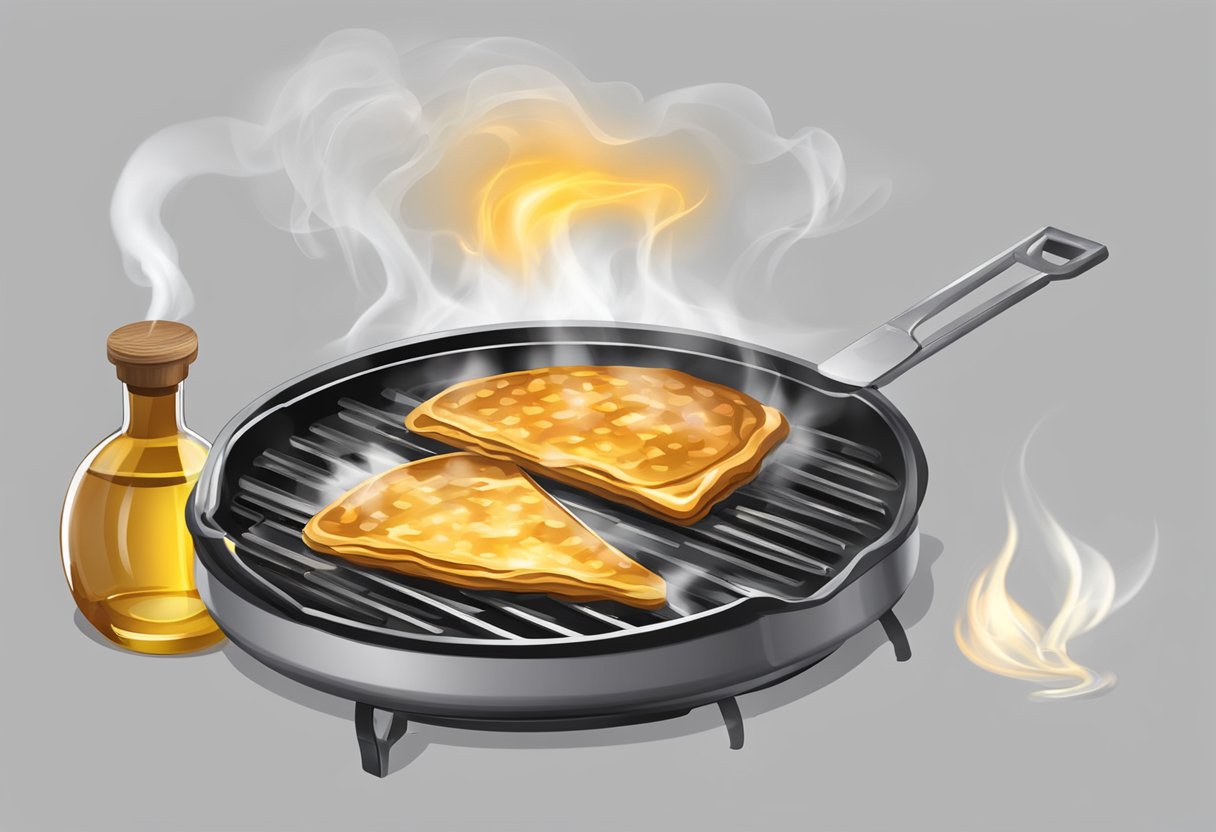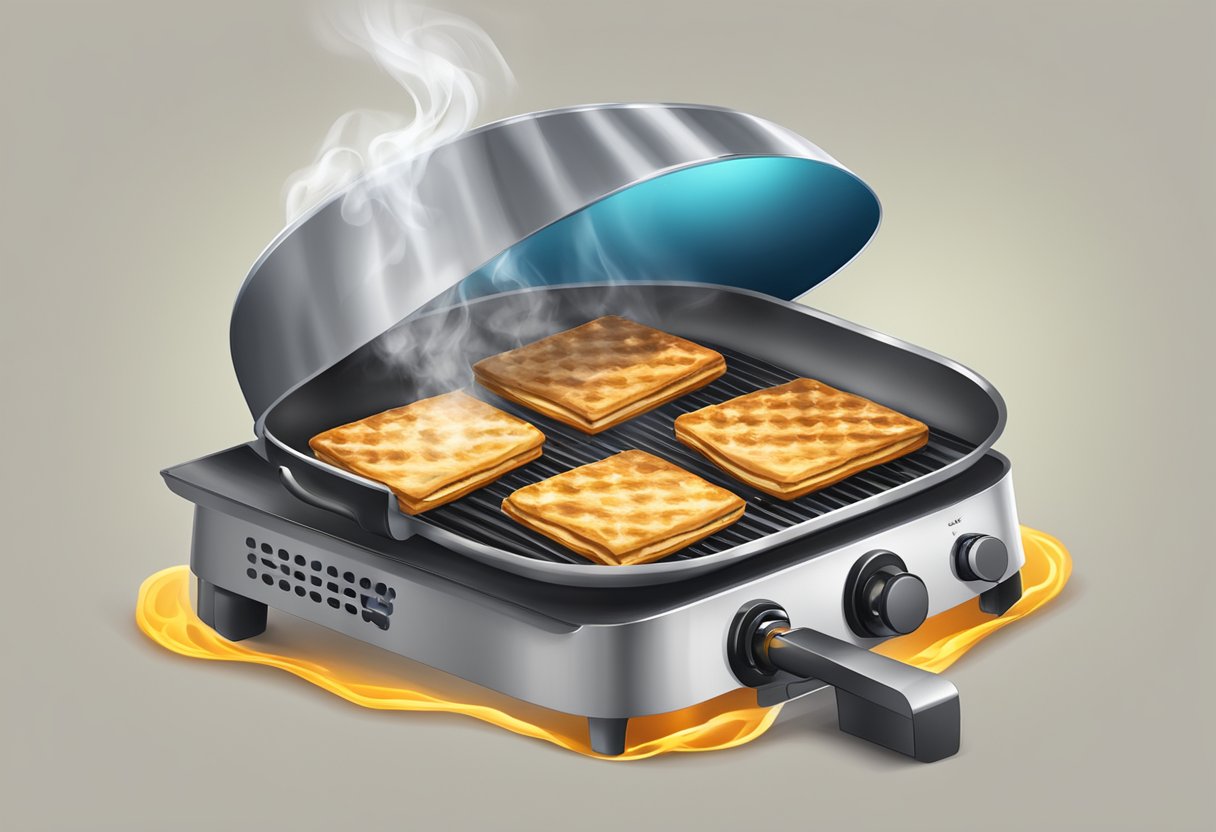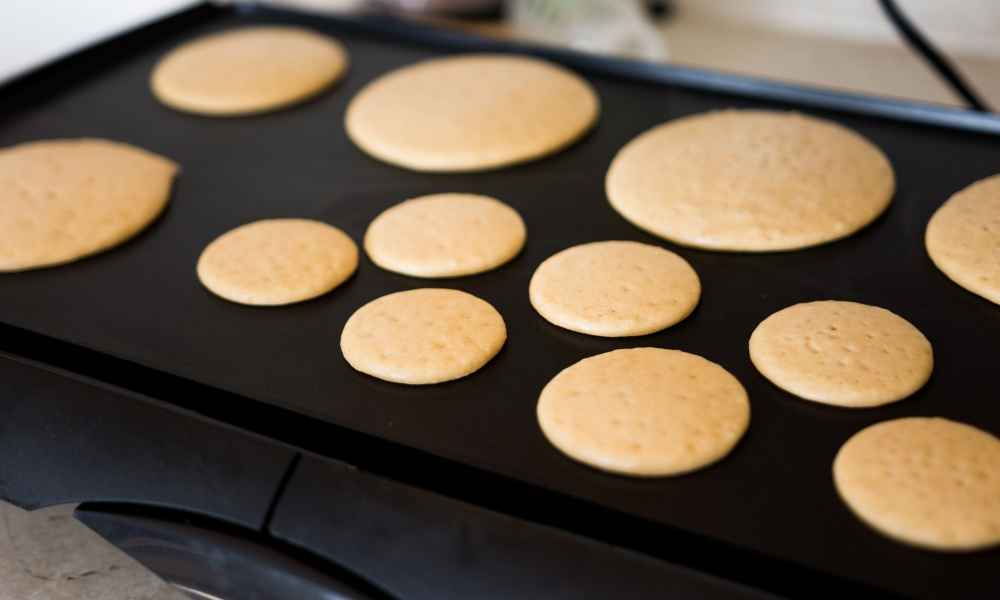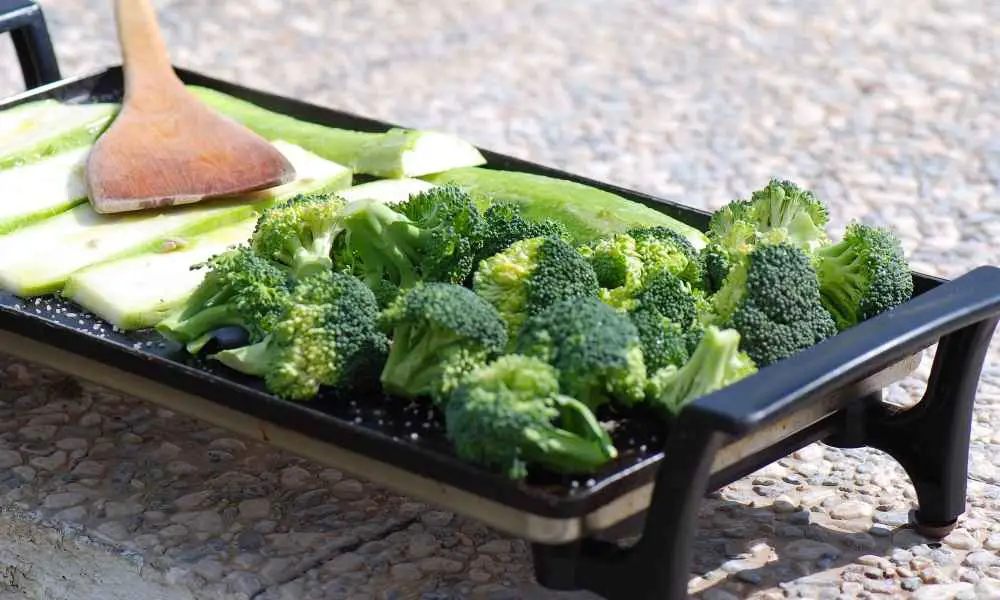Are you looking to cook up some delicious meals on your griddle? If so, it’s important to choose the right oil. Cooking oil is essential when using a flat top grill like a Blackstone, Camp Chef, or Pit Boss. With so many oil options available, it can be challenging to pick the best one to cook with on your griddle.

Canola oil is often rated as the finest oil for griddle cooking, and it is also chosen as the most remarkable oil overall. Even when used in unconventional ways, canola oil never imparts any off-putting tastes to meals. It also has the capability of withstanding breakdowns caused by high temperatures for an extended time. Other great oil options for griddle cooking include sunflower seed oil and avocado oil, which have high smoke points and are widely available in shops and supermarkets.
Choosing the right oil for your griddle can make a big difference in the taste and quality of your food. Whether you’re cooking up breakfast, lunch, or dinner, the right oil can help you achieve the perfect sear, crisp, or caramelization. So, before you start cooking on your griddle, take the time to choose the right oil that will help you achieve the perfect flavor and texture.
Understanding Griddle Oil
https://www.youtube.com/watch?v=c55JueCPgkg&embed=true
When it comes to cooking on a griddle, using the right oil is crucial. Griddle oil is specifically designed for use on griddles and has a higher smoke point than regular cooking oil, which means it can withstand higher temperatures without smoking or breaking down.
Using the wrong oil can result in a burnt or off-flavored meal, so it’s important to choose the right oil for your griddle. Here are some things to consider when selecting a griddle oil:
Smoke Point
The smoke point of oil is the temperature at which it begins to smoke and break down, resulting in a burnt taste and potentially harmful compounds. Different oils have different smoke points, so it’s important to choose an oil with a smoke point that’s suitable for high-heat cooking.
Flavor
Some oils, such as olive oil, have a distinct flavor that can affect the taste of your food. If you’re looking for a neutral flavor, consider using a more neutral oil, such as canola or vegetable oil.
Non-Stick Properties
Using the right oil can help prevent food from sticking to your griddle. Oils with high smoke points and non-stick properties, such as avocado oil, are ideal for griddle cooking.
Health Considerations
Some oils, such as coconut oil, are high in saturated fats, which can increase cholesterol levels. If you’re looking for a healthier option, consider using oils that are high in unsaturated fats, such as canola or olive oil.
Overall, choosing the right griddle oil is essential for achieving a delicious and perfectly cooked meal. Consider the smoke point, flavor, non-stick properties, and health considerations when selecting an oil for your griddle.
Types of Griddle Oil
https://www.youtube.com/watch?v=lLYKSkNPVhk&embed=true
When it comes to griddle cooking, choosing the right oil is crucial. Different oils can contribute different tastes to your food, while others work best at different temperatures. Here are the most common types of griddle oil you can use:
Vegetable Oil
Vegetable oil is a popular choice for griddle cooking due to its mild flavor and high smoke point. It is also affordable and widely available. However, vegetable oil is high in omega-6 fatty acids, which can contribute to inflammation in the body when consumed in excess.
Canola Oil
Canola oil is another popular choice for griddle cooking. It has a neutral flavor and a high smoke point, making it ideal for high-heat cooking. Canola oil is also a good source of heart-healthy monounsaturated fats and omega-3 fatty acids.
Peanut Oil
Peanut oil is a flavorful oil that is commonly used in Asian cuisine. It has a high smoke point and is ideal for high-heat cooking. Peanut oil is also a good source of vitamin E and heart-healthy monounsaturated fats.
Grapeseed Oil
Grapeseed oil has a mild flavor and a high smoke point, making it a good choice for griddle cooking. It is also a good source of vitamin E and antioxidants. However, grapeseed oil is high in omega-6 fatty acids, which can contribute to inflammation in the body when consumed in excess.
Avocado Oil
Avocado oil is a healthy oil that is ideal for griddle cooking. It has a high smoke point and is rich in heart-healthy monounsaturated fats. Avocado oil also contains antioxidants and anti-inflammatory compounds. It has a mild flavor that won’t overpower your food.
When choosing a griddle oil, consider the smoke point, flavor, and health benefits. Experiment with different oils to find the one that works best for your cooking needs.
Importance of Griddle Oil
https://www.youtube.com/watch?v=gz6bp8r-gEs&embed=true
When cooking on a griddle, using the right oil is essential to ensure that your food doesn’t stick to the surface. Griddle oil creates a barrier between your food and the griddle, preventing it from sticking and making it easier to cook. In addition to preventing sticking, griddle oil can also help to season the surface of your griddle. This seasoning helps to create a non-stick surface that is easy to clean and maintain.
Choosing the right griddle oil is important. You want to use an oil with a high smoke point, so it doesn’t burn and create smoke while you’re cooking. Some of the best oils for griddle cooking include vegetable oil, canola oil, and olive oil. These oils have high smoke points and are versatile enough to be used in a variety of dishes.
When applying griddle oil, it’s important to use a thin, even layer. This will ensure that your food doesn’t stick to the surface and will help to create a non-stick surface over time. You can apply griddle oil using a clean cloth or brush, making sure to cover the entire cooking area.
Overall, using the right griddle oil is essential to ensure that your food cooks evenly and doesn’t stick to the surface of your griddle. By choosing an oil with a high smoke point and applying it in a thin, even layer, you can create a non-stick surface that is easy to clean and maintain.
How to Apply Griddle Oil
https://www.youtube.com/watch?v=jkKoVX0d04I&embed=true
When it comes to griddle cooking, applying oil to your griddle is essential to prevent food from sticking and to achieve a perfectly cooked meal. Here are some tips on how to apply griddle oil.
Preparation
Before you apply oil to your griddle, make sure it is clean and dry. You can use a scraper or spatula to remove any debris or leftover food from the surface. Once the griddle is clean, turn on the heat to medium-high and let it warm up for a few minutes. This will help open up the pores of the metal surface, making it easier for the oil to penetrate and create a non-stick surface.
Application
When it comes to applying oil to your griddle, less is more. You don’t want to use too much oil, as it can cause flare-ups and smoke. Instead, use a brush or paper towel to apply a thin layer of oil evenly over the entire surface, including the corners and edges. Some of the best oils to use on a griddle include vegetable oil, canola oil, and avocado oil.
If you’re using a new griddle, you should apply oil before the first use. This will help season the griddle and create a non-stick surface. To do this, apply a thin layer of oil to the griddle and let it heat up for about 10 to 15 minutes. Once the oil starts to smoke, turn off the heat and let the griddle cool down. This process can be repeated several times until the griddle is fully seasoned.
Aftercare
After you’re done cooking, it’s important to clean your griddle properly. You can use a scraper or spatula to remove any leftover food or debris from the surface. Once the griddle is clean, you can use a paper towel or cloth to wipe off any excess oil. This will help prevent the oil from going rancid and keep your griddle in good condition.
In conclusion, applying oil to your griddle is an important step in achieving perfectly cooked meals. By following these tips, you can ensure that your griddle is properly seasoned and that your food doesn’t stick to the surface.
Common Mistakes When Using Griddle Oil
https://www.youtube.com/watch?v=OTx-01ou4t4&embed=true
When using a griddle, there are some common mistakes that people make when it comes to oiling the surface. Here are some of the most common mistakes and how to avoid them:
Using Too Much Oil
One of the most common mistakes people make when oiling a griddle is using too much oil. While it may seem like more oil will create a better seasoning, it can actually lead to a sticky and uneven surface. It is recommended to use a thin layer of oil and spread it evenly across the surface of the griddle. You can use a paper towel or a brush to spread the oil.
Using the Wrong Type of Oil
Another common mistake is using the wrong type of oil. Some oils have a low smoke point and can burn easily, which can lead to a bad taste and even smoke. It is recommended to use an oil with a high smoke point, such as canola oil, avocado oil, or vegetable oil. These oils can withstand high temperatures without burning.
Not Cleaning the Griddle Properly
If you don’t clean your griddle properly, it can lead to a buildup of oil and food particles, which can affect the taste of your food and even lead to rust. Make sure to clean your griddle after each use and remove any excess oil or food particles. You can use a scraper or a spatula to remove any stuck-on food, and then wipe the surface with a paper towel or a cloth.
Not Re-Oiling the Griddle
After cleaning your griddle, it is important to re-oil the surface to prevent rust and maintain the seasoning. Make sure to use a thin layer of oil and spread it evenly across the surface of the griddle. You can also use a spray bottle to apply the oil. Re-oiling your griddle will ensure that it stays in good condition and lasts longer.
By avoiding these common mistakes, you can ensure that your griddle stays in good condition and provides you with delicious meals every time you use it.
Griddle Oil Alternatives

If you’re looking for alternatives to traditional griddle oils, there are a few options to consider. These alternatives can provide unique flavors and health benefits to your cooking.
Coconut Oil
Coconut oil is a popular alternative to traditional griddle oils. It has a high smoke point and a unique flavor that can add a tropical twist to your dishes. It is also a good source of healthy fats and antioxidants.
Ghee
Ghee, or clarified butter, is another alternative to traditional griddle oils. It has a high smoke point and a rich, nutty flavor that can add depth to your dishes. It is also a good source of healthy fats and vitamins.
Bacon Grease
Bacon grease is a flavorful alternative to traditional griddle oils. It has a high smoke point and a smoky, savory flavor that can add richness to your dishes. However, it is high in saturated fat and should be used in moderation.
Avocado Oil
Avocado oil is a healthy alternative to traditional griddle oils. It has a high smoke point and a mild, nutty flavor that can complement a variety of dishes. It is also a good source of healthy fats and antioxidants.
Conclusion
When it comes to griddle oil alternatives, there are a variety of options to choose from. Whether you’re looking for unique flavors or health benefits, these alternatives can provide a tasty twist to your cooking.
Storing Griddle Oil

When it comes to storing your griddle oil, there are a few things you should keep in mind to ensure that your oil stays fresh and ready to use. Here are some tips to help you store your griddle oil properly:
Use a Squeeze Bottle
One of the easiest ways to store your griddle oil is to use a squeeze bottle. This will allow you to easily dispense the oil onto your griddle without having to worry about spills or messes. Make sure to choose a bottle that is made of a material that is safe for use with cooking oil, such as plastic or glass.
Keep it in a Cool, Dark Place
To ensure that your griddle oil stays fresh for as long as possible, it’s important to store it in a cool, dark place. Exposure to light and heat can cause your oil to spoil more quickly, so try to keep it away from direct sunlight and sources of heat, such as your stove or oven.
Label Your Oil
If you use different types of oil for different cooking purposes, it’s a good idea to label your oil so that you can easily identify it. This can help prevent mix-ups and ensure that you’re using the right oil for the job.
Check for Spoilage
Before using your griddle oil, it’s important to check for signs of spoilage. If your oil has a rancid smell or taste, or if it appears cloudy or discolored, it’s time to replace it. Using spoiled oil can not only ruin the taste of your food, but it can also be harmful to your health.
By following these simple tips, you can ensure that your griddle oil stays fresh and ready to use whenever you need it.
Conclusion

In conclusion, choosing the right oil for your griddle cooking is important to ensure that your food is cooked to perfection. Griddle oil is specifically designed for use on griddles and has a higher smoke point, which means it can withstand higher temperatures without smoking or breaking down.
When it comes to choosing the best oil for your griddle, it is important to consider factors such as smoke point, flavor, and health benefits. Some of the best oils for griddle cooking include olive oil, avocado oil, and vegetable oil.
It is also important to note that different oils are better suited for different types of food. For example, olive oil is great for cooking meats and vegetables, while coconut oil is better suited for sweet dishes like pancakes and French toast.
Ultimately, the best oil for your griddle cooking will depend on your personal preferences and the type of food you are cooking. Experiment with different oils and find the one that works best for you. Remember to always use high-quality oil and avoid using oils that have gone rancid.
By following these tips, you can ensure that your griddle cooking is both delicious and healthy.
Frequently Asked Questions
https://www.youtube.com/watch?v=SKg5AujP2cI&embed=true
What’s the best oil for seasoning a griddle?
When it comes to seasoning your griddle, you want to use an oil with a high smoke point such as canola oil, grapeseed oil, or avocado oil. These oils will create a non-stick surface on your griddle and help prevent rusting. Apply a thin layer of oil to your griddle and heat it up until it starts smoking. Then, let it cool down and repeat the process a few times until you have a nice, even coating.
Can I use canola oil on my griddle?
Yes, canola oil is a great choice for griddle cooking. It has a high smoke point of around 400°F, which makes it perfect for high-heat cooking on your griddle. It’s also a healthy option because it’s low in saturated fat and high in monounsaturated fat.
What’s the best oil for a stainless steel griddle?
Stainless steel griddles are great for cooking because they heat up quickly and evenly. To keep your stainless steel griddle in good condition, you want to use an oil with a high smoke point such as avocado oil, grapeseed oil, or canola oil. These oils will help prevent sticking and keep your griddle looking shiny and new.
Is grapeseed oil a good choice for griddle cooking?
Yes, grapeseed oil is an excellent choice for griddle cooking because it has a high smoke point of around 420°F. It’s also a healthy option because it’s low in saturated fat and high in polyunsaturated fat. Grapeseed oil is also flavorless, which means it won’t interfere with the taste of your food.
What high temp oil should I use on my Blackstone griddle?
Blackstone griddles are known for their high heat output, so you want to use an oil with a high smoke point such as canola oil, grapeseed oil, or avocado oil. These oils can withstand temperatures of up to 500°F, which makes them perfect for cooking on your Blackstone griddle.
How do I clean my griddle and what oil should I use for cleaning?
To clean your griddle, you want to use a scraper or spatula to remove any food debris. Then, wipe it down with a paper towel or cloth. If there’s any stubborn residue left, you can use a mixture of water and vinegar to clean it off. After cleaning, you want to apply a thin layer of oil to your griddle to prevent rusting. Any high smoke point oil such as canola oil, grapeseed oil, or avocado oil will work for cleaning.


